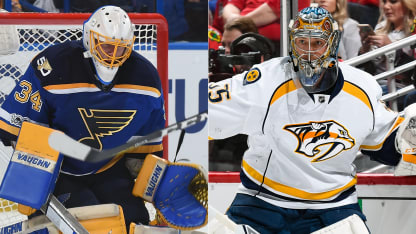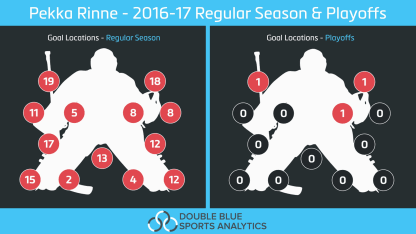Rebounds off the rush: Allen was getting caught flat, or parallel to the goal line, instead of squaring up on rush chances down the wing before working with Brodeur to rotate as these plays moved deeper in the zone. The old habit contributed to 18 against the grain, or cross-body far-side goals, but he easily handled high attempts by the Wild. A better bet now may be throwing shots off his far pad, with rebounds more likely to go back into the slot because of his new angle, or create lateral plays off these attacks, which almost led to an Eric Staal wraparound goal in Game 3 because Allen has a bigger rotation to make before pushing back across.
Glove love:Allen also switched his glove model around the same time the Blues changed coaches, moving to a deeper double-T pocket with skate laces that help take the spin off shots and retain pucks. Not that Allen's glove was a problem; of the 41 mid to high glove-side goals in the regular season, 34 involved a combination of screens (16), one-timers (nine), deflections (13) and lateral plays. Wild forward Charlie Coyle found out on a Game 1 rebound chance that Allen's glove is just fine. As he showed while getting across compact and in control to take Coyle's chance away, the high totals around the edges are a sign it takes a great shot to score because he isn't going to open a lot of holes.
Sightlines key:The old adage about taking the eyes away from a hot goalie ring true. After the Blues' coaching change, 37 percent of the goals against Allen involved a screen, well above the 23.3-percent average of the 2,100-plus goals tracked. The Wild scored twice in five playoff games with screens.



















